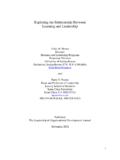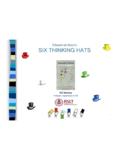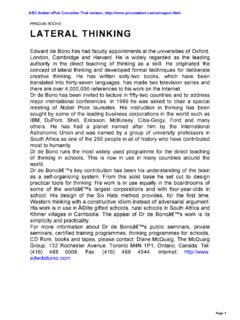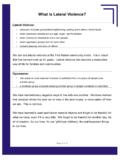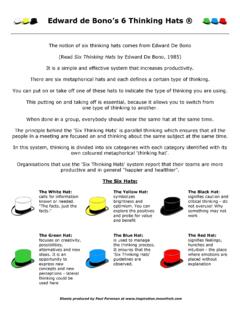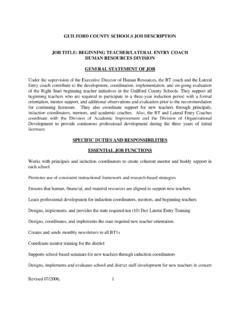Transcription of Lessons on the Path: “Seven Thinking Hats” Spiritual ...
1 INTEGRATIVE LEADERSHIP INTERNATIONAL Helping individuals and organizations become integrated. Lessons on the Path: 1 March 12, 2005 Volume 1, No. 27 seven Thinking hats Richard John Hatala _____ OBSERVATION: A few weeks ago I participated in a one day program called the Six Thinking hats . I found the workshop refreshing in that it allowed me to experience being a student/participant again, reconnect with a simple and practical method of adopting multiple perspectives, and gave me a little time to think about the whole idea of Thinking once again.
2 I was particularly excited about how the six Thinking styles related to our emerging integrative model of life and leadership. De Bono s Six (+ One) Thinking HatsIntegrative Leadership Model &De Bono s Six(+ One) Thinking HatsPhysical IntelligenceEmotionalIntelligenceMentalI ntelligenceSpiritual IntelligenceNew Hat?Redefine Old Hat? Edward De Bono, the author of Six Thinking hats who is a medical doctor (MD), Doctor of the Arts (PhD) and Rhodes Scholar is one of the world s foremost authorities on Thinking . Since 1993, over 300 thousand people from companies such as IBM, Coca Cola, Dupont and Microsoft, have been taught his various perspectives on the science and art of Thinking .
3 The purpose of his six hats method is to allow individuals, groups and teams to consciously untangle and unbundle their normal chaotic Thinking processes (that result from attempting to do too much all at once) and move towards the clarity of what De Bono calls, parallel Thinking . In parallel Thinking , there is an opportunity to move from competition (argumentative as win-lose) towards cooperation (discussing as win-win) by endeavouring to view a situation from the same perspective, with the same attitude, utilizing the same Thinking style, all at the same time.
4 His six-hat method has been proven to cultivate flexibility, fluency and adaptability, which are characteristics that allow more creativity to be experienced in our life and work. De Bono further suggests that we can shift from one Thinking style to another as easily as we can put on or take off a hat. Hence the metaphor linking Thinking styles to hats and their associated colours. The White Hat calls for information known or needed. "The facts, just the facts." The Yellow Hat symbolizes brightness and optimism. Under this hat you explore the positives and probe for value and benefit The Black Hat is judgment - the devil's advocate or why something may not work.
5 Spot the difficulties and dangers; where things might go wrong. Probably the most powerful and useful of the hats but a problem if overused. The Red Hat signifies feelings, hunches and intuition. When using this hat you can express emotions and feelings and share fears, likes, dislikes, loves, and hates. The Green Hat focuses on creativity; the possibilities, alternatives, and new ideas. It's an opportunity to express new concepts and new perceptions. The Blue Hat is used to manage the Thinking process. It's the control mechanism that ensures the Six Thinking hats guidelines are observed.
6 De Bono s six Thinking styles are: White hat (detective) What do we know? Black hat (critic) What is wrong and why it won t work? ; Yellow hat (champion) What is right and why it will work? ; Green hat (innovator) Let s examine all the ways it could work or ways it may help lead us to a unique or original solution? ; Red hat (artist) How do you feel, what is your gut instinct or intuitive sense telling you about it? ; Blue hat (observer) which is the hat that manages the overall Thinking process. In addition to the what of the six hats , we also learned how we could use them in various sequences to help shorten meetings, create options, or generate alternatives.
7 The sequence of Thinking styles, our facilitator 2 emphasized, is very important. For example, you would never use black hat Thinking just before green hat Thinking . Critical Thinking , used too early in a process, kills creativity. After the workshop was officially over, several of us began to discuss De Bono s Six Thinking Styles in an attempt to relate them with various personality (MBTI) and leadership models. Using our integrative model of life and leadership as a foundation, we correlated the six Thinking styles to the four domains of intelligence (see the figure above), Jung s temperaments and several other models.
8 Later, in examining the pattern of the six hats that we had associated with the four domains of intelligence, there seemed to be an imbalance between the emotional domain, that De Bono represented as one red hat, and the mental domain, which he represented as two hats ; one black (negative) and one yellow (positive). The integrative model would suggest that the red emotional hat should be redefined and divided into two hats that would correspond to the duality of the mental domain as optimistic versus pessimistic, benefits versus detriments, pros versus cons.
9 We then tried to imagine what this new hat would feel like when we put it on? After our reflection, we concluded that this new hat which we thought should be purple would be the positive, appreciative, more life-giving style of intuitive Thinking that contained emotions such as faith, hope and joy. Whereas the red hat would be redefined and aligned with the more common negative, cynical, more death-dealing style of instinctual Thinking that contained emotions such as fear, guilt and shame. In our journey these past years, we found that to move from red, black and white Thinking styles to yellow, purple and green Thinking styles we needed determination, perseverance, courage and grace.
10 By adding a seventh hat to De Bono s Six Thinking Hat model, it rationally and intuitively became more aligned with our emerging integrative framework and more universal when viewed from our all too human condition, a condition that is being transformed as we move from the sixth to the seventh principle of our being. _____ APPLICATION: Reflect this week on your predominant style of Thinking . Are you wearing and residing within black hat Thinking where you continually look for what is wrong with your world? Or do you spend time in yellow hat Thinking that searches for what is right with your world?
